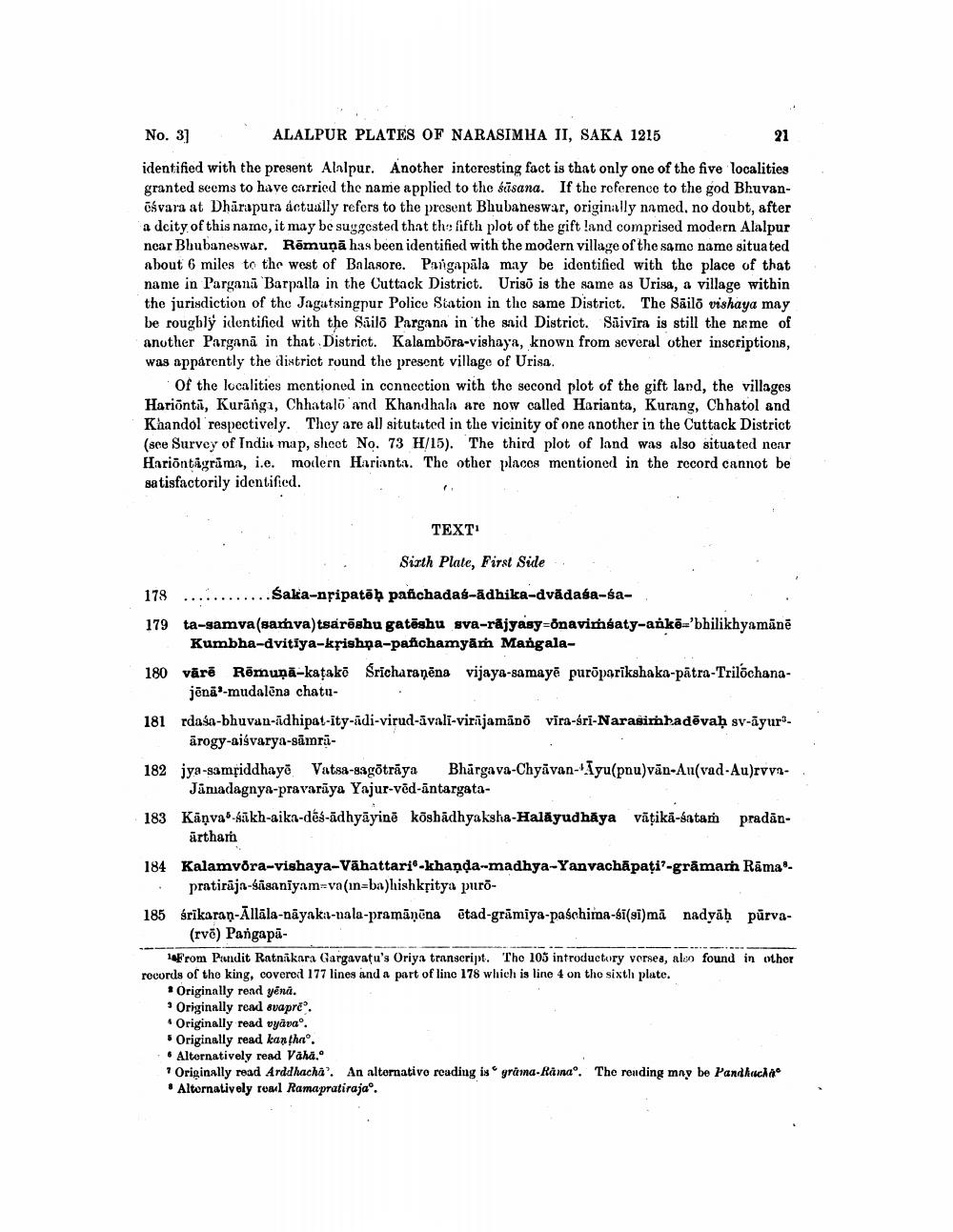________________
21
No. 3] ALALPUR PLATES OF NARASIMHA JI, SAKA 1215 identified with the present Allpur. Another interesting fact is that only one of the five localities granted seems to have carried the name applied to the suisana. If the reference to the god Bhuvanośvara at Dharapura actually refers to the present Bhubaneswar, originally named, no doubt, after a dcity of this namo, it may be suggested that the fifth plot of the gift land comprised modern Alalpur near Bhubaneswar. Rēmunā has been identified with the modern village of the same name situated about 6 miles to the west of Bninsore. Pangapāla may be idontified with the place of that name in Pargana Barpalla in the Cuttack District. Uriso is the same as Urisa, a village within the jurisdiction of the Jagutsingpur Police Station in the same District. The Sailo vishaya may be roughly identified with the Sailo Pargana in the said District. Säivira is still the name of another Pargana in thnt District. Kalambora-vishaya, known from several other inscriptions, was apparently the district round the present village of Urisa.
of the localities mentioned in connection with the second plot of the gift land, the villages Hariönti, Kurangi, Chhatalo and Khandhala are now called Harianta, Kurang, Chhatol and Khandol respectively. They are all situated in the vicinity of one another in the Cuttack District (see Survey of Indii map, sheet No. 73 H/15). The third plot of land was also situated near Hariontågrūma, i.e. modern Harianta. The other places mentioned in the record cannot be satisfactorily identified.
TEXT:
. Sirth Plate, First Side, 178 ............ Saka-nfipatāḥ pañchadas-adhika-dvädaga-sa179 ta-samva(samva)tsarēshu gatēshu sva-rajyasy-onavimšaty-ankē='bhilikhyamānē
Kumbha-dvitiya-kfishpa-pafchamyām Mangala180 vārē Rēmuņā-katakē Sricha raņēna vijaya-samayē puròparikshaka-pātra-Trilochana
jēnā'-mudalēna chatu181 rdasa-bhuvan-adhipat-ity-ādi-virud-avali-virījamāno vira-sri-Narasimhadēvaḥ sv-ayur
arogy-aišvarya-sāmā182 jya-samțiddhayē Vatsa-sagotrāya Bhargava-Chyāvan-Iyu(pnu)vān-Au(vad-Au)rvv2
Jámadagnya-pravarāya Yajur-vēd-āntargata183 Kāņva -sakh-aika-dés-ādhyāyinē köshādhyaksha-Halāyudhāya vātikā-satam pradān
ārtham 184 Kalamvora-vishaya-Vāhattari®-khanda-madhya-Yanvachāpati?-gråmam Rāma
pratirājn-sāsaniyam=va(in=ba)hishksitya puro185 srikaran-Allāla-nāyaka-nala-pramāṇāna ētad-grāmiya-paschima-si(si)mā nadyāḥ pūrva
(rvē) Pangapa10From Pundit Ratnikara Gargavatu's Oriya transcript. The 105 introductory verses, also found in other records of tho king, covered 177 lines and a part of line 178 which is line 4 on the sixth plate.
* Originally read yêna.
Originally read avapro'. • Originally read vyāvao.
* Originally read kantha. + Alternatively read Váha."
* Originally read Arddhacha'. An alternativo reading is grama-Rama'. The reading my be Pandhacha . Alternatively real Ramapratirajao.




